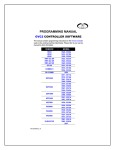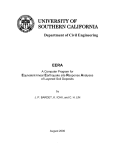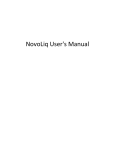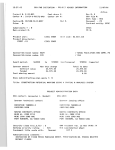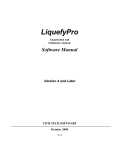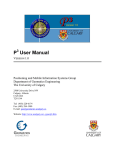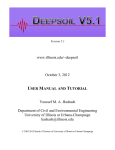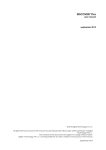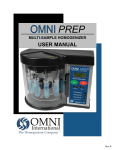Download WSliq User`s Manual
Transcript
Appendix H WSliq User’s Manual This manual presents a description of how the WSliq program can be used to perform a variety of important liquefaction hazard analyses. The WSliq program was created as part of an extended research project supported by the Washington State Department of Transportation (WSDOT). The WSliq program is intended to allow WSDOT engineers to evaluate liquefaction hazards more accurately, reliably, and consistently, and to do so more efficiently than is possible even with the more limited procedures commonly used in contemporary geotechnical engineering practice. The WSliq program should only be used after reading the report within which this User’s Manual is contained. The report provides important information on the procedures used to perform the various liquefaction hazard analyses possible with WSliq, and it is essential that users be familiar with those procedures and the information required to complete them before using WSliq. WSliq is organized in a manner similar to that with which a liquefaction hazard evaluation would normally be conducted. In such an evaluation, an engineer would generally be required to answer three questions: 1. Is the soil susceptible to liquefaction? 2. If so, is the anticipated earthquake loading strong enough to initiate liquefaction? 3. If so, what will be the effects of liquefaction? The WSliq interface, therefore, is divided into three main tabs devoted to susceptibility, initiation, and effects. Along with tabs that facilitate entry of soil profile data and examination/documentation of results, these define the basic user interface. This User’s Manual is graphically oriented, i.e., it presents the required data by reference to the locations at which that data are entered on the various WSliq forms. H-1 Welcome Tab The Welcome tab provides two primary functions: a place for entry of global information—i.e., information potentially required for all desired analyses—and an introduction to the purpose of the WSliq program. The required global data consist of information required to identify the site and ground motion hazards at the site. A screen shot of the Welcome tab is shown in Figure H.1. Figure H.1 WSliq Welcome Tab. The global information requested on the Welcome form, and the purpose of the Data Process button found on that form, are described in Table H.1: H-2 Table H.1. Required Information and Buttons on Welcome Screen. Text Box Information Item Comments Enter alphanumeric description of site. This information will be written to the Site: Report to help identify the site. Enter alphanumeric description of job/project number. This information will be Job No.: written to the Report to help identify the site. Enter latitude in decimal degrees. All latitude values must exist within Latitude: Washington State. Enter longitude in decimal degrees. All longitude values must exist within Longitude: Washington State. Analyst: Enter alphanumeric description (name) that describes person performing analyses. Buttons Item Data Process: Comments Used to specify location (path) of ground motion hazard data files. Only needed if user wishes to store ground motion hazard databases in locations other than the default locations defined during program installation. Soil Profile Tab The Soil Profile tab (Figure H.2) allows entry of data that define the soil profile, for the purposes of liquefaction hazard evaluation, at the site of interest. The soil profile is defined by a series of sublayers, within which all properties are assumed to be constant, and information required for the various analyses is entered on a sublayer-by-sublayer basis. H-3 Figure H.2 WSliq Soil Profile Tab. Table H.2. Required Information and Buttons on Soil Profile Tab. Upper Level Text Box Information Item Comments Number of Soil Layers: GWT at top of layer: SPT Energy Ratio: Ground surface elevation Infinite slope: Free-face ratio: Enter integer number of soil layers used to define subsurface profile Enter layer number corresponding to groundwater table. Note that sublayers much be arranged such that the groundwater table coincides with the top of some sublayer. Enter SPT energy ratio, ER, in percent. Value used to correct measured SPT resistance. Enter elevation of ground surface in appropriate units For ground slope geometries (lateral spreading analysis), enter ground slope in percent. For free-face geometries (lateral spreading analysis), enter free-face ratio in percent. Soil Profile Data Text Box Information Item Comments Description: Enter alphanumeric soil description (up to 30 characters) Designate whether or not the layer is undrained (default condition for layers Undr? below water table). Soils not expected to maintain undrained conditions (e.g., H-4 h: DTC: Unit Weight: Meas. SPT: FC: D50: Init. Vert. Eff. Stress: (N1)60: Vs: Buttons Item +/- Amp. Factor Pore Pressure Calculate Open Data File Save Data File Plot Soil Profile Batch clean gravel) can be designated as non-liquefiable by removing check mark from check box. Enter sublayer thickness Depth to center of layer (computed from sublayer thicknesses) Enter sublayer unit weight (not density) Enter measured SPT resistance Enter measured fines content in percent. Estimate if not available. Enter mean grain size (used for Youd et al. lateral spreading analysis). Estimate if not available. Vertical effective stress at center of layer (computed from unit weight, thickness, and water table data) Value of (N1)60 computed from initial vertical effective stress and energy ratio. This value is NOT fines-corrected. Shear wave velocity (computed from (N1)60 and vertical effective stress using Ohta and Goto relationship; used in Cetin et al. liquefaction model) Comments Allows insertion of new layer above or below layer for which button was clicked. Opens new form on which PGA amplification factor (relative to NEHRP B/C boundary) can be entered. Amplification factor value can be entered directly, or in terms of a and b coefficients used in indicated Stewart-type relationship. Opens window in which initial pore pressures can be entered. Window should open with hydrostatic pore pressure values shown; values can be changed, if necessary, to accommodate perched water table or other situations that can produce non-uniform initial pore pressure profile. Uses entered soil profile data to compute initial vertical effective stress and corrected SPT resistance Allows an existing soil profile data file to be entered into WSliq Allows entered soil profile data to be saved in data file Produces plots of initial vertical effective stress, measured and corrected SPT resistance, fines content, and plasticity index with depth Opens window allowing batch analysis to be specified. Susceptibility analysis must be performed before specifying parameters of batch analysis. User can decide in advance which analyses (liquefaction initiation, lateral spreading, post-liquefaction settlement, etc.) are to be performed. Susceptibility Tab The Susceptibility tab (Figures H.3) allows convenient computation of the Susceptibility Index (SI) and use of the SI to evaluate the susceptibility of each layer in the soil profile. The SI provides a quantitative measure of liquefaction susceptibility that allows a user to compare the relative susceptibilities of different layers. The SI value is also used in subsequent calculations H-5 to account for epistemic uncertainty in liquefaction susceptibility. In those calculations, the user can choose to consider only soil layers judged to be susceptible to liquefaction or to consider all layers with their contributions weighted by the SI value; in that case, the SI value is treated as a subjective probability, or degree of belief, of susceptibility. Figure H.3. Liquefaction Susceptibility Tab Table H.3. Required Information and Buttons on Soil Profile Tab. Text Box Information Item Comments Enter plasticity index for each layer. Note that the notation ‘N.P.’ (non-plastic) PI: will appear in this box for all layers with zero fines. Enter ratio of water content to liquid limit in decimal form. Note that the wc/LL: notation ‘N.P.’ (non-plastic) will appear in this box for all layers with zero fines. Enter threshold value of Susceptibility Index for judgment of soil as liquefiable. Threshold Entering a threshold value of 0.0 will cause all layers to be treated as susceptible SI: to liquefaction in subsequent calculations. H-6 Slider control Item Comments Use slider to select weighting factors to be applied to Boulanger-Idriss and BrayWeighting Sancio procedures for evaluation of liquefaction potential. Weighting factor factors: values will automatically add up to 1.0. Buttons Item Evaluate Comments Computes susceptibility index values for Boulanger-Idriss and Bray-Sancio models, computes Susceptibility Index according to weighting factors, and denotes susceptibility (in yes/no manner) by comparing Susceptibility Index with threshold value. The results of the susceptibility evaluation are expressed in terms of SI values for both the Boulanger-Idriss and Bray-Sancio procedures, as described in Chapter 4. A weighted average SI value is then compared with the threshold SI value selected by the user to judge whether or not the soil is susceptible to liquefaction. The user should note that many of the subsequent calculations (liquefaction potential, lateral spreading, etc.) do not include non-susceptible layers. All layers can be forced to be susceptible by setting the threshold SI value to zero; the results of any analyses performed in this manner should be reviewed and interpreted carefully. Initiation Tab The Initiation tab has a series of three sub-tabs that allow entry of data for singlescenario, multiple-scenario, and performance-based analyses of liquefaction potential. The required data are described below. Single-Scenario Analyses Single-scenario analyses can be performed in two basic ways: by inputting any desired combination of peak ground surface acceleration and magnitude, or by inputting peak ground surface acceleration values associated with a particular return period and the corresponding (mean or modal) magnitude values. In the latter case, the program determines the appropriate amax and M values from the hazard database. Figure H.4 shows the single-scenario sub-tab, and Table H.4 describes the input required to perform single-scenario analyses. H-7 Figure H.4 WSliq Single-Scenario Liquefaction Initiation Tab. The results of single-scenario analyses are displayed graphically as plots of FSL and Nreq vs. depth and numerically in tabular form in the window below the plots. Clicking on either of the plots will produce a larger version of the plot. Right-clicking on any plot will allow various characteristics of the plot to be edited. The numerical data can be accessed within the singlescenario tab or on the Report tab; they can also be saved on the Report tab. H-8 Table H.4. Required Information and Buttons on Single-Scenario Liquefaction Initiation Tab. User-Defined Loading Parameter Information Item Comments Enter peak ground surface acceleration in g’s. Note that this acceleration Peak surface value is assumed to account for local site conditions (e.g., amplification of acceleration: rock acceleration values). Enter magnitude to be used in single-scenario analysis. Note that this magnitude value is not required to be related to the peak acceleration value Magnitude: (however results with inconsistent acceleration and magnitude values should be interpreted very carefully). PSHA-Defined Loading Parameter Information Item Comments Enter desired return period in years. Loading data (peak acceleration and Return Period: magnitude) is interpolated from ground motion hazard database. Select mean or modal magnitude to be used in magnitude scaling factor Magnitude: calculation. Additional Input Item Comments Enter a factor of safety value of interest. This option plots a line at that Reference FS: factor of safety to allow easy comparison of calculated factors of safety with user-defined criteria. The probability of liquefaction (PL) to be used in Cetin et al. deterministic Cetin’s PL: analysis. Value of 0.6 has been found to produce similar results to NCEER model at shallow depths. Liquefaction Models Item Comments Select to compute FSL and Nreq using NCEER, Idriss-Boulanger, and Cetin et Select All al. procedures. NCEER IdrissBoulanger Cetin et al. Buttons Item Update Help Compute Select individually as desired to compute FSL and Nreq values. Comments Plot the reference FS. Display brief description of PL for Cetin’s model. Computes FSL and Nreq using selected procedures. H-9 Multiple-Scenario Analyses Multiple-scenario analyses are easily performed with WSliq. The user is simply required to provide a return period of interest, and the program obtains the required data from the ground motion hazard database. Figure H.5 shows the multiple-scenario sub-tab, and Table H.5 describes the input required to perform multiple-scenario analyses. Figure H.5 WSliq Multiple-Scenario Liquefaction Initiation Tab. The results of multiple-scenario analyses are displayed graphically as plots FSL and Nreq vs. depth and numerically in tabular form in the window below the plots. Clicking on either of the plots will produce a larger version of the plot. The numerical data can be accessed within the multiple-scenario tab or on the Report tab; they can also be saved on the Report tab. H-10 Table H.5. Required Information and Buttons on Multiple-Scenario Liquefaction Initiation Tab. Loading Parameter Information Item Comments Enter desired return period in years followed by carriage return to display Return Period: corresponding peak ground acceleration. Additional Input Item Reference FS: Cetin’s PL: Comments Enter a factor of safety value of interest. This option plots a line at that factor of safety to allow easy comparison of calculated factors of safety with user-defined criteria. The probability of liquefaction (PL) to be used in Cetin et al. deterministic analysis. Value of 0.6 has been found to produce similar results to NCEER model at shallow depths. Liquefaction Models Item Comments Select to compute FSL and Nreq using NCEER, Idriss-Boulanger, and Cetin Select All et al. procedures. Select to compute FSL and Nreq as weighted average of values given by WSDOT Recommended NCEER, Idriss-Boulanger, and Cetin et al. procedures. NCEER Idriss-Boulanger Cetin et al. Buttons Item Update Help Compute FS Histogram Mw Histogram Select individually as desired to compute FSL and Nreq values. Comments Plot the FS criterion, drawing a dashed line at the specified FS value. Display brief description of PL for Cetin’s model. Computes FSL and Nreq using selected procedures. Displays histogram of computed FSL values reflecting variability in magnitudes contributing to PGA ground motion hazard at selected return period. Displays histogram of magnitudes contributing to PGA ground motion hazard for selected return period. Performance-Based Analyses Performance-based analyses are also easily performed with WSliq. As discussed in Section 5.6.3, the Cetin et al. liquefaction potential model was used for performance-based analyses. The user is simply required to provide a return period for plotting purposes, and the program obtains the required data from the ground motion hazard database. Figure H.6 shows the performance-based analysis sub-tab, and Table H.6 describes the input required to perform performance-based analyses. H-11 Figure H.6 WSliq Performance-Based Liquefaction Initiation Tab. Table H.6. Required Information and Buttons on Performance-Based Liquefaction Initiation Tab. Loading Parameter Information Item Comments Enter desired return period in years. The return period does not influence the Return Period: liquefaction hazard curves, but is used to produce the FSL and Nreq vs. depth profiles. Exceedance Probability Information Item Comments Select a probability of exceedance and an exposure period of interest. WSliq will plot results for the corresponding return period. Note that the Probability of Exceedance: performance-based calculations are not repeated, rather the already computed curves are used to obtain the FSL and Nreq values at the indicated hazard level. Buttons Item Compute Comments Computes FSL and Nreq hazard curves and profiles of FSL and Nreq corresponding to return period of interest. The performance-based calculations are voluminous, and will take a couple minutes to complete; a progress bar below the Compute button will display the progress of the calculations. Do not attempt to move to another tab while these calculations H-12 are being performed – it could cause the program to crash. The results of performance-based analyses are displayed graphically as plots of FSL and Nreq hazard curves, and plots of FSL and Nreq vs. depth for the return period of interest. The results are presented numerically in tabular form in the window below the exceedance probability box. WSliq also tabulates the return period of liquefaction (i.e., the return period corresponding to FSL = 1.0) for each depth. Clicking on any of the plots will produce a larger version of the plot. The numerical data can be accessed within the performance-based tab or on the Report tab; they can also be saved on the Report tab. Effects Tab The Effects tab has a series of four sub-tabs that deal with the alteration of ground motions, lateral spreading, post-liquefaction settlement, and the residual strength of liquefied soil. The lateral spreading and post-liquefaction settlements tabs each have three sub-tabs that allow entry of data for single-scenario, multiple-scenario, and performance-based analyses of lateral spreading and settlement. Response Spectrum The occurrence of liquefaction is known to alter the temporal and frequency characteristics of ground surface motions. Research on the effects of liquefaction on ground surface motions (which was beyond the scope of work of the WSDOT-funded study) is continuing at the University of Washington. The preliminary results of that research have been implemented into a simple model for response spectrum modification. The response spectrum tab allows estimation of a response spectral ratio, defined as the ratio of spectral acceleration from an effective stress analysis (which accounts for pore pressure generation) to the spectral acceleration from a total stress analysis (which does not). The response spectrum produced by a total stress (e.g., SHAKE) analysis can be multiplied by the response spectral ratio to produce an improved estimate of the spectral accelerations that would be produced at a site underlain by potentially liquefiable soils. This tab provides some general guidance on the anticipated average relationship between the response spectrum with pore pressure effects and the response spectrum without pore H-13 pressure effects. It should be noted that the research on which it was based showed high levels of uncertainty in this relationship for specific input motions and soil profiles; interpretation of these results should be performed with that fact in mind. Figure H.7 WSliq Response Spectrum Tab. Table H.7. Required Information and Buttons on Response Spectrum Tab. Input Information Item Comments FSL,min: The minimum FS against liquefaction, found from all soil layers. Buttons Item Compute Comments Computes the median response spectral ratio at periods ranging from 0.01 to 1.0 sec. Lateral Spreading The Lateral Spreading tab has a series of three sub-tabs that allow entry of data for single-scenario, multiple-scenario, and performance-based analyses of lateral spreading. Prior to H-14 the performance of any lateral spreading analysis, however, it is important to make sure that the ground slope or free-face ratio has been entered on the Soil Profile tab (Figure H.2). The required data for each type of analysis are described below. Single-Scenario Analyses As in the case of Initiation, single-scenario lateral spreading analyses can be performed in two basic ways. Because the inputs to lateral spreading models consist of magnitude and distance, the scenarios are defined by magnitude and distance. Therefore, scenarios can be defined by the user inputting any desired combination of magnitude and distance, or by inputting a particular return period and selecting the corresponding (mean or modal) magnitude and distance values. Figure H.8 shows the single-scenario sub-tab and Table H.8 describes the input required to perform single-scenario analyses. Figure H.8 WSliq Single-Scenario Lateral Spreading Tab. H-15 The results of single-scenario analyses are displayed graphically in a bar chart and numerically in tabular form in the window below the plots. The numerical data can be accessed within the single-scenario tab or on the Report tab; they can also be saved on the Report tab. Table H.8. Required Information and Buttons on Single-Scenario Lateral Spreading Tab. User-Defined Loading Parameter Information Item Comments Enter magnitude to be used in single-scenario analysis. Note that this magnitude Mag.: value does not have to be related to the distance value (however results based on inconsistent magnitude and distance values should be interpreted very carefully). Enter distance to be used in single-scenario analysis in km. Note that this distance value does not have to be related to the magnitude value (however Dist.: results based on inconsistent magnitude and distance values should be interpreted very carefully). Enter peak ground surface acceleration in g’s. Note that this acceleration value, which is used to compute the FSL value required by the Idriss and Boulanger PGA: model, should account for local site conditions (e.g., amplification of rock acceleration values). PSHA-Defined Loading Parameter Information Item Comments Enter desired return period in years, followed by carriage return (to display Return corresponding mean and modal magnitudes and distances). Loading data is Period: interpolated from ground motion hazard database. Magnitude: Select mean or modal magnitude. Distance: Select mean or modal distance. Lateral Spreading Models Item Comments Baska & Kramer Youd et al. Idriss & Boulanger Buttons Item Initiation Handling Compute Deagg. Select individually as desired to compute lateral spreading displacements. Note that Idriss & Boulanger computes maximum potential displacements. Comments Allows consideration of potential for initiation of liquefaction in lateral spreading computations. User can specify a threshold factor of safety against liquefaction for inclusion/exclusion of individual soil layers, or can choose to have individual layer contributions weighted by probability of liquefaction. Computes lateral spreading displacement using selected procedures. Plots deaggregation of peak ground acceleration at selected return period by contributions from all magnitudes and distances. H-16 Multiple-Scenario Analyses Multiple-scenario analyses are easily performed with WSliq. The user is simply required to provide a return period of interest, and the program obtains the required data from the ground motion hazard database. Figure H.9 shows the multiple-scenario sub-tab, and Table H.9 describes the input required to perform multiple-scenario analyses. Figure H.9 WSliq Multiple-Scenario Lateral Spreading Tab. The results of multiple-scenario analyses are displayed graphically in a bar chart and numerically in tabular form in the window below the plots. The numerical data can be accessed within the multiple-scenario tab or on the Report tab; they can also be saved on the Report tab. H-17 Table H.9. Required Information and Buttons on Multiple-Scenario Lateral Spreading Tab. Loading Parameter Information Item Comments Return Period: Enter desired return period in years. Liquefaction Models Item Comments Select to compute lateral spreading displacement as weighted average of WSDOT Recommended values given by Baska-Kramer and Youd et al. procedures. Baska-Kramer Youd et al. Idriss & Boulanger Buttons Item Initiation Handling Compute Deagg. Select individually as desired to compute lateral spreading displacements. Note that Idriss & Boulanger computes maximum potential displacements. Comments Allows consideration of potential for initiation of liquefaction in lateral spreading computations. User can specify a threshold factor of safety against liquefaction for inclusion/exclusion of individual soil layers, or can choose to have individual layer contributions weighted by probability of liquefaction. Computes lateral spreading displacement using selected procedures. Plots deaggregation of peak ground acceleration at selected return period by contributions from all magnitudes and distances. Performance-Based Analyses Performance-based lateral spreading analyses are also easily performed with WSliq. As described in Section 6.6.3, the Kramer-Baska model is used in performance-based lateral spreading predictions. The program obtains the required data from the ground motion hazard database. Figure H.10 shows the performance-based analysis sub-tab, and Table H.10 describes the input required to perform performance-based analyses. H-18 Figure H.10 WSliq Performance-Based Lateral Spreading Tab. The results of performance-based analyses are displayed graphically as a lateral displacement hazard curve. Numerical values of the hazard curve can be obtained by entering data in the text boxes above the hazard curve plot, followed by a carriage return. H-19 Table H.10. Required Information and Buttons on Performance-Based Lateral Spreading Tab. Loading Parameter Information Item Comments Enter source of ground motion hazard data. For sites in Washington, Data source selection built-in database should be used. Results Item Lateral displacement: Mean Annual Rate of Exceedance: Return Period: Buttons Item Compute Plot Ground Motion Deaggregation Plot Lateral Spreading Deaggregation Comments Enter a lateral spreading displacement value, followed by a carriage return, to obtain the corresponding mean annual rate of exceedance and return period from the hazard curve. Enter a mean annual rate of exceedance value to obtain the corresponding lateral spreading displacement and return period from the hazard curve. Enter a return period to obtain the corresponding lateral spreading displacement and mean annual rate of exceedance from the hazard curve. Comments Computes lateral displacement hazard curve. Plots deaggregation of peak ground acceleration at selected return period by contributions from all magnitudes and distances. Plots deaggregation of lateral spreading displacement at selected return period by contributions from all magnitudes and distances. Settlement The Settlement tab has a series of three sub-tabs that allow entry of data for singlescenario, multiple-scenario, and performance-based analyses of post-liquefaction settlement. The required data for each type of analysis are described below. Single-Scenario Analyses As in the case of Initiation, single-scenario settlement analyses can be performed in two basic ways. Because the loading-related input to lateral spreading models is in the form of cyclic stress ratio, the scenarios are defined by peak acceleration and magnitude. Therefore, scenarios can be defined by the user inputting any desired combination of peak acceleration and magnitude, or by inputting a particular return period and selecting the corresponding (mean or H-20 modal) magnitude value. Figure H.11 shows the single-scenario sub-tab, and Table H.11 describes the input required to perform single-scenario analyses. Figure H.11 WSliq Single-Scenario Settlement Tab. The results of single-scenario analyses are displayed graphically in a bar chart and numerically in tabular form in the window below the plots. The numerical data can be accessed within the single-scenario tab or on the Report tab; they can also be saved on the Report tab. H-21 Table H.11. Required Information and Buttons on Single-Scenario Settlement Tab. User-Defined Loading Parameter Information Item Comments Enter magnitude to be used in single-scenario analysis. Note that this magnitude value is not required to be related to the peak acceleration value (however results Magnitude: based on inconsistent magnitude and acceleration values should be interpreted very carefully). Enter peak ground surface acceleration in g’s. Note that this acceleration value PGA: should account for local site conditions (e.g., amplification of rock acceleration values). PSHA-Defined Loading Parameter Information Item Comments Enter desired return period in years, followed by carriage return (to display Return corresponding mean and modal magnitudes and distances). Loading data is Period: interpolated from ground motion hazard database. Magnitude: Select mean or modal magnitude. Settlement Models Item Comments Select to compute post-liquefaction settlement using Tokimatsu-Seed, IshiharaSelect All Yoshimine, Shamoto et al., and Wu-Seed procedures. TokimatsuSeed IshiharaYoshimine Shamoto et al. Wu-Seed Buttons Item Initiation Handling Compute Deagg. Select individually as desired to compute post-liquefaction settlements. Comments Allows consideration of potential for initiation of liquefaction in settlement computations. User can specify a threshold factor of safety against liquefaction for inclusion/exclusion of individual soil layers, or can choose to have individual layer contributions weighted by probability of liquefaction. Computes settlement using selected procedures. Plots deaggregation of peak ground acceleration by contributions from all magnitudes and distances. Multiple-Scenario Analyses Multiple-scenario analyses are easily performed with WSliq. The user is simply required to provide a return period of interest, and the program obtains the required data from the ground H-22 motion hazard database. Figure H.12 shows the multiple-scenario sub-tab, and Table H.12 describes the input required to perform multiple-scenario settlement analyses. Figure H.12 WSliq Multiple-Scenario Settlement Tab. Table H.12. Required Information and Buttons on Multiple-Scenario Settlement Tab. Loading Parameter Information Item Comments Return Period: Enter desired return period in years. Liquefaction Models Item Comments TokimatsuSeed IshiharaYoshimine Shamoto et al. Wu-Seed Buttons Item Select individually as desired to compute post-liquefaction settlements. Comments H-23 Initiation Handling Compute Deagg. Allows consideration of potential for initiation of liquefaction in settlement computations. User can specify a threshold factor of safety against liquefaction for inclusion/exclusion of individual soil layers, or can choose to have individual layer contributions weighted by probability of liquefaction. Computes settlement using selected procedures. Plots deaggregation of peak ground acceleration at selected return period by contributions from all magnitudes and distances. The results of multiple-scenario analyses are displayed graphically in a bar chart and numerically in tabular form in the window below the plots. The numerical data can be accessed within the multiple-scenario tab or on the Report tab; they can also be saved on the Report tab. Performance-Based Analyses Performance-based post-liquefaction settlement analyses are also easily performed with WSliq. As discussed in Section 7.6.3, the Wu and Seed model was used to develop the performance-based model. The program obtains the required data from the ground motion hazard database. Figure H.13 shows the performance-based analysis sub-tab, and Table H.13 describes the input required to perform performance-based analyses. H-24 Figure H.13 WSliq Performance-Based Settlement Tab. The results of performance-based analyses are displayed graphically as a lateral displacement hazard curve. Numerical values of the hazard curve can be obtained by entering data in the text boxes above the hazard curve plot, followed by a carriage return. H-25 Table H.13. Required Information and Buttons on Performance-Based Settlement Tab. Loading Parameter Information Item Comments Enter source of ground motion hazard data. For sites in Washington, builtData source selection in database should be used. Results Item Settlement: Mean Annual Rate of Exceedance: Return Period: Buttons Item Compute Plot Deaggregation Comments Enter a settlement value, followed by a carriage return, to obtain the corresponding mean annual rate of exceedance and return period from the hazard curve. Enter a mean annual rate of exceedance value to obtain the corresponding settlement and return period from the hazard curve. Enter a return period to obtain the corresponding settlement and mean annual rate of exceedance from the hazard curve. Comments Computes settlement hazard curve. Note that these calculations are voluminous (due to the requirement of integrating over the maximum volumetric strain distributions) and proceed relatively slowly. A progress bar is provided to indicate the progress of the calculations. If you move to another application while these calculations are being performed, the progress bar graphics may not display properly when you return to WSliq – the calculations are still being performed, however, and the final graphics will be displayed properly when the calculations are completed. Plots deaggregation of settlement by contributions from all magnitudes and distances. Residual Strength WSliq allows estimation of residual strength by using a variety of residual strength models and allows the computation of a user-defined weighted average residual strength. Figure H.14 shows the residual strength tab, and Table H.14 describes the input required to estimate residual strength. The results of residual strength analyses are displayed graphically as plots of residual strength vs. depth and numerically in tabular form in the window below the plots. The residual strength plots use solid circles for strengths based on corrected SPT resistances that are within the range of each model, and open circles for strength values extrapolated to higher SPT resistances. Extrapolated strengths should be interpreted carefully. The numerical data can be H-26 accessed within the Residual Strength tab or on the Report tab; they can also be saved on the Report tab. Figure H.14 Residual strength tab. Table H.14. Required Information and Buttons on Residual Strength Tab. Input Information Item Comments Check boxes corresponding to layers for which estimated residual strengths are Select Soil desired. Only layers for which liquefaction is expected to be initiated are Layers available for residual strength calculation Check boxes corresponding to models for which estimated residual strengths Select are desired. Checking WSDOT Recommended box will produce results for Residual Strength Idriss-Boulanger, Kramer-Wang hybrid, and Olson-Stark models, and weighted Models average of those results. Add Weighted Average Buttons Item Compute Legend Check to use user-defined weighting factors for residual strength estimation. Comments Computes residual strength using selected procedures. The legend immediately to the right of the residual strength plots is interactive H-27 – clicking on any of the boxes that indicate the color of each residual strength model will highlight the results of that model. Clicking on the blank box above and to the right of the legend will clear all highlighted curves Report Tab The Report tab provides the means for documenting the results of WSliq analyses in a simple text file. As shown in Figure H.15, the Report tab contains a series of check boxes for each of the various analyses that can be performed with WSliq. By selecting the desired check boxes, the user can write the results of the corresponding analyses to an RTF (rich text file) file. These data can then be further processed by using spreadsheets or other graphics programs. Copies of the plots generated by WSliq can also be written directly to the file, from which they can be copied and pasted into other documents. Figure H.15 Report Tab. Table H.15. Required Information and Buttons on Report Tab. H-28 Buttons Item Generate Report Preview Comments Generates report file based on selected text, picture, and file format options. Opens report in a small window (Figure H.16). Figure H.16 Report preview window. H-29 Appendix I WSliq Database Update Instructions The seismic hazard database that comes with the WSliq program was created by downloading seismic hazard data on a grid across Washington State from the USGS website. When a user enters an arbitrary latitude and longitude, the program interpolates the seismic hazard data for the site of interest using an inverse distance weighting procedure (i.e one in which the contributions of the nearby grid points are weighted in inverse proportion to their distance from the site). For particularly important projects, and for projects near faults where seismicity may change rapidly over relatively short distances, more accurate results may be possible by downloading data for the site latitude and longitude and adding it to the database. Also, the USGS hazard mapping procedures change periodically, for example when new attenuation relationships are developed or when new sources are added, so that it may be necessary to update the database. This appendix provides instructions for expanding and/or updating the seismic hazard database. Two procedures are required to update the seismic hazard database for WSLiq analysis program. The first procedure involves downloading the raw seismic hazard data from the USGS website, and the second one imports the downloaded files to the WSliq seismic hazard database. Downloading USGS Files 1. Go to the 2002 Interactive Deaggregations page at the USGS Seismic Hazard Mapping website. (http://eqint.cr.usgs.gov/deaggint/2002/index.php). As of the date of this report, the following page will appear. I-1 2. Input the site info in the corresponding text boxes. The site latitude and longitude must be input in decimal format (two digits), and the longitude is a negative number for locations in America. A convenient latitude and longitude converter (from degreeminute-second to decimal degrees) can be found at http://www.fcc.gov/mb/audio/bickel/DDDMMSS-decimal.html 3. Choose one Return Period of interest. There are six return periods from which to choose, and this process will be repeated for each. 4. Set the Frequency selection to ‘PGA.’ 5. Leave the last two options (Geographic Deaggs and Stochastic Seismograms) as their defaults. 6. Press the “Generate Output” button to produce the deaggregation file. 7. A new web page will appear. Click on the link for “Report,” and a text file will open in the web browser. Save this file (use File --> Save As) in a temporary folder on your hard drive with the specific filename determined using the following rules: a. The file has the name “Latitude_Longitude_xx.txt” (underscore characters required). b. The ‘Latitude’ and ‘Longitude’ in the filename should be replaced with the numerical coordinates corresponding to the site’s location, and ‘xx’ should be replaced by the 50-yr exceedance probability (to identify the return period). The table below indicates the required ‘xx’ values. I-2 Value of xx 01 02 05 10 20 50 Return Period, yr 4975 (1% in 50 yrs) 2475 (2% in 50 yrs) 975 (5% in 50 yrs) 475 (10% in 50 yrs) 225 (25% in 50 yrs) 108 (50% in 75 yrs) c. For example, if the site of Test #1 is located at (47.53N, 122.50W), and the deaggregation data corresponds to a return period of 4975 yrs, then the data should be saved in a file called: 47.53_122.50_01.txt . Save this file to a temporary folder (e.g., “NewGrid”) in the hard drive. 8. Repeat Step 3-8 for all other return periods. For each location, six deaggregation data files will be downloaded and saved to the hard drive. Importing and Processing USGS Files 1. Open the WSliq program. The button labeled “Data Process” in the upper-right corner will do the work of importing the new deaggregation files created in last procedure. 2. If the button is not active (not shadowed), it means that the WA database has been installed in the default location (c:\WSDOT_LiqSys_Database) or the database is installed at the location given in the “DatabasePath.txt” file defined during installation (See the ReadMe file when downloading the WSLiq program). Simply move the database folder to a different hard drive, or change the folder’s name, then close WSLiq and reopen it. This will activate the “Data Process” button. 3. Click the “Data Process” button. A “Data Processing” window will pop up. This window provides the option to add the new grid points (downloaded in the previous procedure) to the database. 4. Select “Add Grids (USGS)” in the USGS/EZFRISK Data Processing window. I-3 5. Assign the data folder of existing database under USGS Data Folder: in the Open Existing Database area of the window. This should be the folder you moved (or named) in Step 2. 6. In the “Add/Del Grids” panel, click on “New grid files”. A folder browser will pop up. Choose the folder in which you saved the downloaded USGS files (the temporary folder in Step 7 of the previous procedure). Note: just choose the folder, not the file itself. 7. Click the “Add” button and the program will process the USGS files and add the new grid points into WA database. If the database has the same grid points as the ones you try to add, a warning message will appear and ask if you want to overwrite the data with the new files. 8. When the “Adding grids is done” message pops up, the data processing job is finished. Click “OK” to close the message. 9. Click “Back to WSLiq” button to go back to the WSLiq program. I-4




































